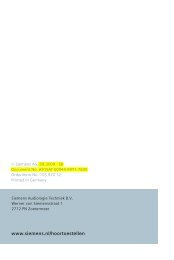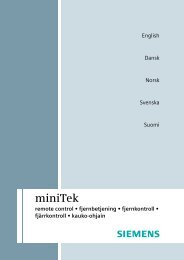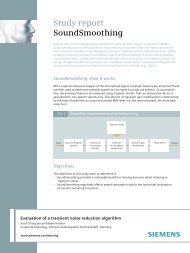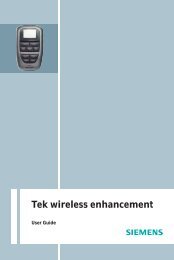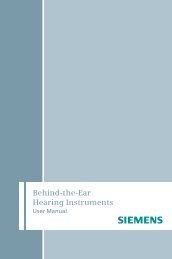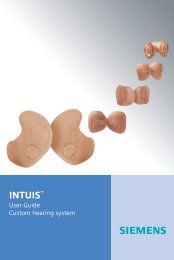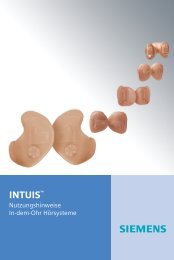CENTRA Active: A new receiver-in-canal solution designed to ...
CENTRA Active: A new receiver-in-canal solution designed to ...
CENTRA Active: A new receiver-in-canal solution designed to ...
You also want an ePaper? Increase the reach of your titles
YUMPU automatically turns print PDFs into web optimized ePapers that Google loves.
IV<br />
Acoustic<br />
advantages<br />
4<br />
Ga<strong>in</strong> / dB<br />
Fig. 3 REOG of open and closed dome<br />
20<br />
15<br />
10<br />
5<br />
0<br />
-5<br />
-10<br />
-15<br />
REUG<br />
Dome closed<br />
Dome open<br />
-20<br />
100 500 1000 4000 10000<br />
Figure 3: Illustration of the real ear occluded ga<strong>in</strong> (REOG) for<br />
both the open and closed domes of <strong>CENTRA</strong> <strong>Active</strong>. The real<br />
ear unaided ga<strong>in</strong> (REUG) is shown for comparison.<br />
Figure 3 shows the real ear unaided ga<strong>in</strong> (REUG) for<br />
the open ear <strong>canal</strong>. Observe that there is 13-17 dB<br />
peak <strong>in</strong> the 2000 <strong>to</strong> 4000 Hz range. In a closed hear<strong>in</strong>g<br />
aid fitt<strong>in</strong>g this open ear advantage is elim<strong>in</strong>ated,<br />
as the <strong>canal</strong> is closed and resonant properties are<br />
altered. However, observe <strong>in</strong> the dark blue curve of<br />
Figure 3, when the <strong>receiver</strong> fitted <strong>in</strong> the open dome<br />
is placed <strong>in</strong> the <strong>canal</strong>, all the open ear effects rema<strong>in</strong>.<br />
The curve for the closed dome shows that there is<br />
nearly no difference <strong>to</strong> the REUG below 1 kHz, but<br />
significant attenuation at higher frequencies. The<br />
follow<strong>in</strong>g sections exam<strong>in</strong>e the consequences of<br />
these acoustic properties on occlusion and feedback<br />
stability.<br />
Occlusion reduction<br />
Frequency / Hz<br />
In addition <strong>to</strong> improved high frequency amplification,<br />
another desired benefit of <strong>CENTRA</strong> <strong>Active</strong> is the<br />
reduction of the occlusion effect. The occlusion effect,<br />
often described as a “hollowness” of one’s own<br />
voice, is known <strong>to</strong> be bothersome, and <strong>in</strong> some <strong>in</strong>stances,<br />
prevents <strong>in</strong>dividuals from us<strong>in</strong>g amplification.<br />
Physically, the occlusion effect relates <strong>to</strong> an <strong>in</strong><br />
<strong>in</strong>crease of sound pressure level at low frequencies<br />
<strong>in</strong>side the ear <strong>canal</strong>. While the curves shown <strong>in</strong> Figure<br />
3 suggest that the ear <strong>canal</strong> is not significantly<br />
occluded below 1 kHz, this is not a direct measure of<br />
the “occlusion effect,” as REOG is measured with an<br />
external signal.<br />
Fig. 4 Occlusion with open and<br />
closed dome<br />
Occlusion / dB<br />
12<br />
10<br />
8<br />
6<br />
4<br />
2<br />
0<br />
-2<br />
250 500<br />
Figure 4: Occlusion measurements for <strong>CENTRA</strong> <strong>Active</strong> fitted<br />
with both the open and closed dome. Results from MacKenzie<br />
2006 for occluded, 2 mm and OC tips shown for comparison.<br />
To confirm that <strong>CENTRA</strong> <strong>Active</strong>’s ear pieces do not<br />
cause an occlusion effect, test<strong>in</strong>g was conducted<br />
with ten <strong>in</strong>dividuals (five males and five females).<br />
Each subject was fitted with the most appropriate<br />
dome size and wire length. The amount of occlusion<br />
was measured by subtract<strong>in</strong>g the level <strong>in</strong> the<br />
open ear <strong>canal</strong> from the level <strong>in</strong> the test condition<br />
(open dome, closed dome). Subjects vocalized an<br />
“ee” dur<strong>in</strong>g the measurements <strong>to</strong> generate an “<strong>in</strong>ternal”<br />
test signal. The results of this test<strong>in</strong>g, us<strong>in</strong>g<br />
the open and closed dome are shown <strong>in</strong> Figure 4.<br />
For comparison, these mean f<strong>in</strong>d<strong>in</strong>gs are displayed<br />
with the mean data from MacKenzie and colleagues<br />
(MacKenzie et al. 2004), which illustrate the expected<br />
amount of occlusion for an occluded and open<br />
fitt<strong>in</strong>g, and a vented fitt<strong>in</strong>g (2-mm vent). No significant<br />
differences between female and male subjects<br />
were observed. Note that with <strong>CENTRA</strong> <strong>Active</strong>, negligible<br />
occlusion is present. Even with the tighter fitt<strong>in</strong>g<br />
closed dome, average occlusion is no more than<br />
2-3 dB – a value that would not be bothersome nor<br />
even noticeable for most patients.<br />
Smooth frequency response<br />
Frequency / Hz<br />
Occluded<br />
2 mm vent<br />
Open <strong>canal</strong><br />
Dome open<br />
Dome closed<br />
1000<br />
There is a direct relationship between sound quality<br />
and the smoothness of the frequency response. The<br />
<strong>receiver</strong> and coupl<strong>in</strong>g system of <strong>CENTRA</strong> <strong>Active</strong> were<br />
optimized <strong>to</strong> provide a smooth response, with extended<br />
amplification <strong>in</strong> the higher frequencies.<br />
Figure 5 illustrates measures taken <strong>in</strong> the ear of the<br />
KEMAR for both the open and closed domes. Notice<br />
that the frequency response of <strong>CENTRA</strong> <strong>Active</strong> is<br />
smooth throughout the frequency range, with high<br />
frequency amplification extend<strong>in</strong>g <strong>to</strong> 8000 Hz.




